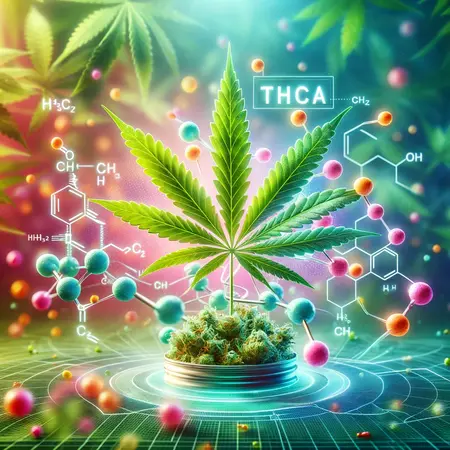THCP: The Compound 30-Times More Potent Than THC!

Most people have heard of THC and know that it is the chemical responsible for marijuana’s intoxicating effects. It is a powerful substance that is capable of significantly impacting both body and mind.
However, scientists have now identified another cannabinoid that is even more potent than THC. It is called delta-9-tetrahydrocannbiphorol, or THCP for short. The research team also isolated a similar CBD analog, CBDP.
Here’s the full story on THCP and CBDP, and why this discovery could be critical to the future of cannabis.
THCP: An Exciting Discovery
In 2019, a research team led by Cinzia Citti attempted to distinguish the specific cannabinoid profile that makes a strain suitable for medicinal use. They performed a series of experiments on an Italian variety of cannabis called FM2.
In the course of their study, they identified the two compounds THCP and CBDP. These cannabinoids are very similar to THC and CBD in structure. However, there is one crucial difference that sets them apart and could make them even more potent than their counterparts.
What Is THCP?
THCP is a phytocannabinoid, one of the hundreds of active compounds that cannabis plants produce in their resinous trichomes. Scientists have identified almost 150 of these chemicals to date, and THCP is the latest on the list.
The beneficial compounds in cannabis include cannabinoids, terpenes, and flavonoids. However, cannabinoids are especially renowned for their medicinal benefits.
There are many different cannabinoids with various properties. Some of the best-known examples include:
- Delta-9-tetrahydrocannabinol (THC)
- Cannabidiol (CBD)
- Cannabichromene (CBC)
- Cannabigerol (CBG)
- Cannabinol (CBN)
How Cannabis Plants Produce THCP
Although there are many different phytocannabinoids, they all have a somewhat similar structure. This is because they all start life as the same molecule, cannabigerolic acid (CBGA).
Many people refer to CBGA as ‘the mother cannabinoid.’ It forms through a complex reaction between olivetolic acid and geranyl pyrophosphate. It then undergoes further enzymatic reactions to become the acidic forms of the phytocannabinoids: THCA, CBDA, CBCA, and so on.
Cannabinoids only exist in their acidic forms in raw cannabis. When they come into contact with heat, a process called decarboxylation occurs. This reaction changes THCA into THC, CBDA into CBD, and CBCA into CBC, etc.
Decarboxylation is a vital process for anyone wishing to create cannabis edibles. Without it, the cannabinoids remain in acidic form and have little effect on the body.
THCPA and CBDPA form in a similar way to these other phytocannabinoids. It is only after exposure to heat that they become THCP and CBDP.
However, unlike the other cannabinoids, THCP and CBDP exist in meager quantities in cannabis plants. For this reason, they have remained hidden until now.
How Is THCP Different from THC?
The molecular structures of THC and THCP are almost identical. The thing that distinguishes them is a part of their make-up called a ‘side alkyl chain.’
An alkyl chain is a string of carbon and hydrogen atoms attached to a molecule. In THC, the alkyl chain consists of five carbon atoms. However, in THCP, it consists of seven.
It is this difference in the length of the alkyl chain that changes the effects of the chemical. It appears that having more carbon atoms in its side chain makes THCP far more potent than THC.
Carbon Chains and Cannabinoids: Size Matters
Although all cannabinoids have a fairly similar chemical structure, the length of the alkyl chains can vary. THCA, CBDA, and CBCA all have five carbon atoms in their alkyl chains.
Some cannabinoids have chains of just three carbon atoms, including THCV and CBDV. These chemicals are known as ‘varinoids.’ Others have chains with a single carbon atom, including THC-C1 and CBD-C1. They are known as ‘orchinoids.’
It appears that phytocannabinoids with longer alkyl chains bind with cannabinoid receptors in the body more readily. For example, some synthetic cannabinoids with alkyl chains longer than five have far more potent effects than THC.
The highest activity occurs with compounds with alkyl chains of eight carbon atoms. If the chain is longer than this, its action begins to decrease.
The reason for this is the way that phytocannabinoids interact with the receptors in the body. These receptors include the CB1 and CB2 receptors that are a crucial element of the endocannabinoid system (ECS).
Longer alkyl chains allow cannabinoids to bind with these receptors more effectively, thus increasing their effects. For this reason, THCP’s seven-long carbon chain makes it more potent than THC, which has a chain of just five.
THCP Benefits and Risks
As part of their study, Citti and colleagues tested the newly discovered THCP on mice. They found that when they administered low doses of 2.5mg/kg, the mice displayed reduced activity levels.
At higher doses of 5mg/kg and 10mg/kg, the chemical’s sedative effects increased. The mice displayed catalepsy, a trance-like state in which the body becomes rigid and unable to move. However, at this dosage, THCP also appeared to possess potent painkilling properties.
The team suggests that THCP may be responsible for the pharmacological effects of some marijuana strains. However, it appears that the benefits of THCP are very much dose-dependent. Although the team did not test THCP on humans, it seems likely that the risk of side effects would be high.
One factor that deters people from using high-THC strains for medical conditions is the risk of adverse reactions. Common examples include dry mouth, sedation, anxiety, paranoia, and dizziness. A stronger substance, such as THCP, could potentially amplify any of these adverse side effects. Therefore, its use would require careful dosing and monitoring to provide genuine benefits.
How Much THCP Is in Cannabis?
As we have already mentioned, THCP and CBDP are far less abundant than THC and CBD. For example, in the Italian FM2 strain, typical levels of the four cannabinoids are as follows:
- THC: 39mg/g
- THCP: 29mcg/g
- CBD: 56mg/g
- CBDP: 243mcg/g
Note that the measurements for THC and CBD are in milligrams, while those for THCP and CBDP are in micrograms.
Each milligram is equal to 1000 micrograms, so the concentrations of these newly discovered cannabinoids are extremely low. No wonder they have escaped the attention of scientists for so long!
At present, we know very little about the THCP content of other cannabis strains. However, this information should become available in the future as research into the cannabinoid continues.
Where Can I Buy THCP?
Botanica By IVY will release THCP cartridges and disposables in Early September!





Comments
These types of cannabinoids find their way to the masses when it's cheap enough to produce at scale. Unfortunately, many times the pioneers don't reap the benefits of getting products to market at an affordable price once a cannabinoid is properly understood.